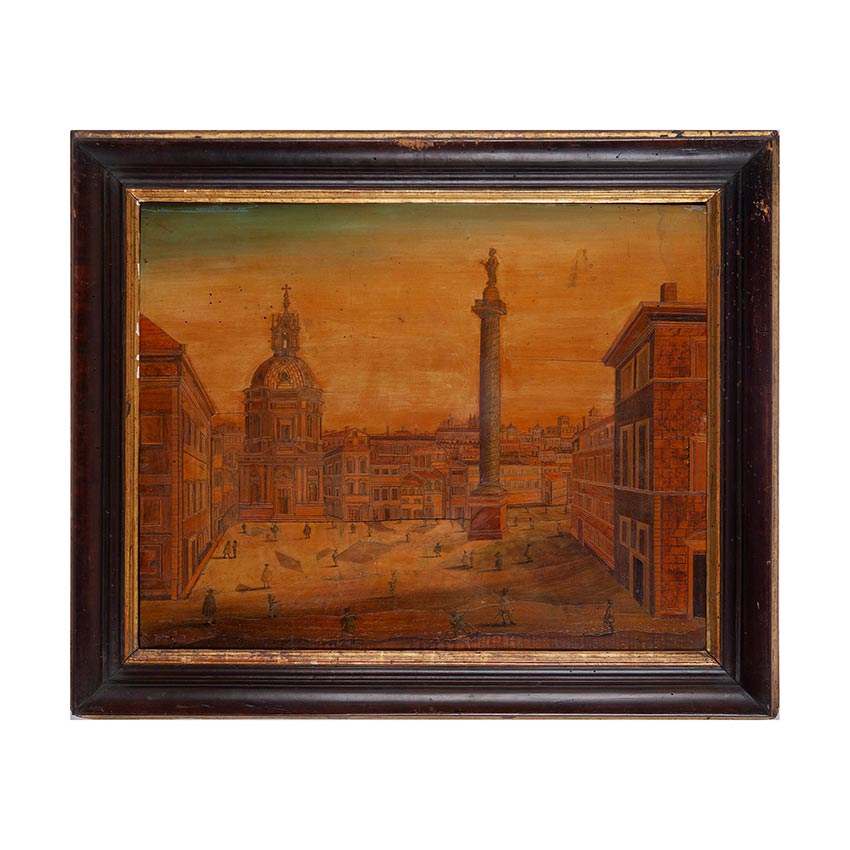Description
Artista sud-tedesco o tirolese, da Matteo Gregorio de’ Rossi, metà XVIII secolo, Due rari pannelli intarsiati con vedute di Roma . Acero inciso, mordenzato e guazzato, acero radica, prugna, ciliegio e vari intarsi in legno di frutta su legno tenero, legno tenero ebanizzato e dorato, montature in ghisa. Sul retro di entrambe le tarsie su tavola è riportata un’iscrizione che descrive i soggetti rappresentati: sulla prima la veduta “Prospectus Columnae Traiani Imp.”, la seconda “Prospectus Comumnae Antonini Pii Imp.” Il putto volante con gli stendardi si vede nella vista della colonna di Traiano nel prototipo stampato, ma qui è raffigurato nella vista della colonna di Antonio Pio. Un pannello con un’etichetta scritta a mano dal produttore Franz Riemb o Kientz e “chur: Tro:” (indistinto). Le stampe su cui si basano i disegni di questi pannelli possono essere viste sul sito del British Museum sotto il n. inv. 1950,0211.27. Il foglio di Matteo Gregorio de´ Rossi fu acquistato nel 1950 come parte di un grande assortimento di 250 stampe italiane della collezione del Granduca di Liechtenstein. Una serie di sei pannelli comparabili con la stessa firma (letta come Kientz) precedentemente nella collezione del Palazzo di Sigmaringen pubblicata da Carlton Hobbs, con vedute del Palazzo di Schleissheim, del Palazzo di Nymphenburg, del Palazzo di Mering e del Palazzo di Lichtenburg. L’artista non identificato fu attivo anche in Baviera e a Roma.
Un pannello noto e pubblicato con una vista a volo d’uccello intarsiata dello Schloss Mannheim in Germania è conservato nel Reiss-Museum di Mannheim, inv. no. A 167a (in: Stratmann-Döhler/Wiese, Möbel für den Fürstenhof, Sigmaringen 1994, illus. 3). Dimensioni ext. 56×66, int. 42×53 cm. cad.
South German or Tyrolean artist, Two rare inlaid panels with views of Rome, mid 18th century, translated from Matteo Gregorio de’ Rossi engravings. Engraved, stained and gouged maple, burl maple, plum, cherry and various fruitwood inlays on softwood, ebonized and gilt softwood, cast iron mounts. On the back of both panel inlays there is an inscription describing the subjects depicted: on the first one the view of the “Prospectus Columnae Traiani Imp.”, the second “Prospectus Comumnae Antonini Pii Imp.” The flying putto with banners is seen in the view of Trajan’s column in the printed prototype, but here it is depicted in the view of Antonini Pius’ column. A panel with a handwritten label by manufacturer Franz Riemb or Kientz and “chur: Tro:” (indistinct). The prints from which the drawings for these panels are translated can be seen on the British Museum website under inv. no. 1950,0211.27. The sheet by Matteo Gregorio de´ Rossi was bought in 1950 as part of a large assortment of 250 Italian prints from the collection of the Grand Duke of Liechtenstein. A series of six similar panels with the same signature (Kientz) previously in the Sigmaringen Palace collection published by Carlton Hobbs, featuring views of Schleissheim Palace, Nymphenburg Palace, Mering Palace, and Lichtenburg Palace. The unidentified artist was also active in Bavaria and Rome.
A well-known and published panel with an inlaid bird’s eye view of Schloss Mannheim in Germany is in the Reiss-Museum, Mannheim, inv. no. A 167a (in: Stratmann-Döhler/Wiese, Möbel für den Fürstenhof, Sigmaringen 1994, illus. 3). Dimensions w. frame 22×26 in., sight 16.5×20.9 in. ea.









Reviews
There are no reviews yet.